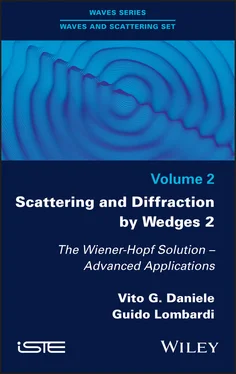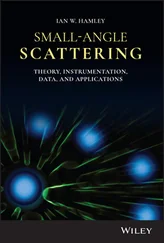In particular, we present one of the most relevant recent advances in the WH technique, i.e. the transformation of WH equations into integral equations for their effective solution via simple discretization.
This method, known as the Fredholm factorization, is an approximate technique that extends the applicability of the WH method to a new variety of problems, consisting of different geometries and materials.
The Fredholm factorization is a semi-analytical solution method that preserves the spectral properties of the problem through its structural singularities and singularities related to the sources. Approximations are present on correction terms that are only related to diffractive properties. Thus, using a suitable analytic continuation, the method allows the reader to look at the physical properties of the problems, as done in analytical closed-form solution methods.
The success of the Fredholm factorization, in solving complex diffraction problems involving isotropic media, has also encouraged the authors to extend the WH technique developed in this book to wedge problems involving anisotropic or, more general, bi-anisotropic media. Moreover, in these cases, the Fredholm factorization is conceptually possible. However, in most cases, it yields complex kernels that involve cumbersome multivalued functions. Much effort is needed to complete the general WH theory for solving wedge problems involving arbitrary linear media. In particular, difficulties increase considerably when it is not possible to take advantage of the presence of Helmholtz equations. In fact, in these cases, it is very difficult and cumbersome to implement the indispensable analytic continuation procedures.
However, to successfully develop the mathematical theory and applications of this book, it is useful to have a technical computing software, particularly in analytical and numerical manipulations of the equations.
Finally, we admit that the authors are strongly influenced by the fundamental work of Felsen and Marcuvitz on radiation and scattering by waves, and therefore the adopted notations follow their studies. In particular, equivalent network representations of equations are provided to systemize the mathematical procedure. The use of different notations in applied physics, applied mathematics and engineering communities should not present a major difficulty in reading this book.
Vito G. DANIELE
Guido LOMBARDI
May 2020
This book consists of two volumes; any references to Chapters 1, 2 or 3 can be found in the first volume: Scattering and Diffraction by Wedges 1 .
Diffraction by objects presenting edges is a fundamental problem in the theory of diffraction. Its importance has been demonstrated by the vast number of papers and books that deal with this topic. These works concern mathematical and physical aspects, with applications to many branches of physics and engineering such as electromagnetism, acoustics, elasticity, aerodynamics and hydrodynamics. To provide a complete theory of the effects of the edges present in a body, we study wedge problems, i.e. canonical problems where the diffracting body is composed of homogeneous wedges. Wedge problems can be classified in different ways. For example, in electromagnetism, we introduce impenetrable and penetrable wedges. Impenetrable wedges arise from the introduction of approximate boundary conditions on the surfaces of wedges. For example, near a metallic face, at microwave frequencies, we can assume that the tangential electrical field vanishes. The introduction of impenetrable wedges simplifies the study of wedge problems considerably since the external problem (i.e. the evaluation of the electromagnetic field outside the wedge) is decoupled from the internal problem (i.e. the evaluation of the electromagnetic field inside the wedge). Considerable advances have been made to obtain more realistic approximate boundary conditions. Unfortunately, the introduction of sophisticated boundary conditions is not sufficient to study penetrable wedges. In particular, the scattering by a penetrable wedge (e.g. the dielectric wedge in electromagnetics) is a very difficult problem that has arisen for a long time and drawn the interest of many scientists.
Nevertheless, even for the simplest cases, no closed-form solution for this problem is known.
The solutions of wedge problems have a long history, which have been well documented by numerous books and papers. This history also documents the importance of the use of spectral representations to obtain the solutions of wedge problems. One of the aims of these two volumes is to claim the power of the representations of the field spectra through Laplace transforms in radial direction. In particular, the use of these representations allows the extension of the powerful WH technique to formulate and efficiently solve many wedge problems.
This book is divided into two volumes that are consistent with each other. The first volume introduces the general theory with simple examples, while the second volume reports more advanced applications. Each volume consists of three chapters and their cross-references.
In each volume, sections, equations and figures are numbered as (chapter.section. item) in order for the content to be easily accessible.
Chapter 1 starts by recalling some fundamental properties of the mathematical theory of the WH technique. The separation of the plus and minus Laplace transforms is fundamental in introducing the concept of the classical factorization, an ingenious idea forming the basis of this technique. This chapter presents a few cases where exact factorizations are available. A novel aspect presented in this chapter is the introduction of the solution procedure for the Fredholm factorization, as an alternative to the classical WH solution procedure. It presents the fundamental advantage of its applicability in general cases where the classical factorizations are not available.
To discuss the importance of the mathematical tools described in Chapter 1, the solution of the most simple diffraction problem is presented in Chapter 2: the electromagnetic scattering of a plane wave by a perfectly electrically conducting (PEC) half-plane. Both the classical factorization procedure and the Fredholm factorization method are applied to obtain the solution of this problem. The comparison of these two different factorization techniques illustrates their advantages and disadvantages. To provide a general methodology for studying basic problems in other diffraction areas, Chapter 2 presents the complete theory of the diffraction of a half-infinite crack located in an indefinite elastic solid.
Chapter 3 deals with the application of the WH technique to wedge problems. This application comes from the introduction of generalized Wiener-Hopf equations (GWHEs) and from the mapping that reduces GWHEs to classical WH equations (CWHEs).
In order to compare the WH technique with the Sommerfeld–Malyuzhinets technique, this chapter introduces two angular complex planes called w and bar w. In this framework, we present a new tool called rotating waves to study angular regions. Moreover, the introduction of angular complex planes is also useful in developing the application of the Fredholm factorization method.
Chapter 4(Volume 2) deals with the solution of impenetrable wedges immersed in free space. Exact solutions obtained with the classical factorization theory are compared with those obtained by the Sommerfeld–Malyuzhinets method.
Chapter 5(Volume 2) is particularly important for the development of immediate engineering applications. In fact, it presents the application of the Fredholm factorization method to the solution of the general scattering problem by an arbitrary impedance wedge illuminated by plane waves at skew incidence.
Читать дальше












